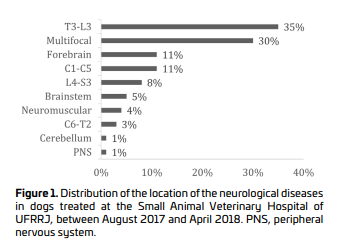Prevalence and clinical features of neurological disorders in dogs attended at Federal Rural University of Rio de Janeiro (2017-2018)
DOI:
https://doi.org/10.21708/avb.2022.16.1.10348Resumo
Neurological disorders are frequent in small animal veterinary clinics and studies giving regional justification for such disorders are essential so that veterinarians can be better prepared. The objective of this retrospective study was to describe the clinical and epidemiological aspects of dogs with neurological disorders treated at the Veterinary Hospital of Federal Rural University of Rio de Janeiro, between August 2017 and April 2018. The study describes the location of the lesions and their etiology according to the acronym VITAMIN-D, as well as the distribution of cases according to sex, breed and age. One hundred and twenty-two (122) dogs were included, of which 58% (n=71) were males and 42% (n=51) females. The age distribution ranged from two months to 18 years old; 16% were less than two years old, 50% between two and seven years old and 34% were more than seven years old. The most affected breeds were Mixed Breed dogs (43%), Poodles (9%) and Dachshunds (7%). The diagnoses were confirmed in 54 animals (44%) and in 68 (56%) remained presumptive. The most common location was the spinal cord (61%), where the T3-L3 region was the most affected (35%), followed by multifocal (20%) and forebrain (10%). The most frequent categories were degenerative (24%), inflammatory/infectious (23%) and traumatic (20%) diseases. Intervertebral disc disease was the most observed, corresponding to 21.3% of all cases. The results showed that the neurological diseases in this Veterinary Hospital were more prevalent in young male adults with spinal cord diseases of degenerative nature.
Downloads

Downloads
Publicado
Edição
Seção
Licença
Autores que publicam na Acta Veterinaria Brasilica concordam com os seguintes termos: a) Autores mantém os direitos autorais e concedem à revista o direito de primeira publicação, com o trabalho simultaneamente licenciado sob a Licença Creative Commons Attribution que permite o compartilhamento do trabalho com reconhecimento da autoria e publicação inicial nesta revista. b) Autores têm autorização para assumir contratos adicionais separadamente, para distribuição não-exclusiva da versão do trabalho publicada nesta revista (ex.: publicar em repositório institucional ou como capítulo de livro), com reconhecimento de autoria e publicação inicial nesta revista. c) Autores têm permissão e são estimulados a publicar e distribuir seu trabalho online (ex.: em repositórios institucionais ou na sua página pessoal) a qualquer ponto antes ou durante o processo editorial, já que isso pode gerar alterações produtivas, bem como aumentar o impacto e a citação do trabalho publicado (Veja O Efeito do Acesso Livre).


 Esta obra está licenciada com uma Licença
Esta obra está licenciada com uma Licença 